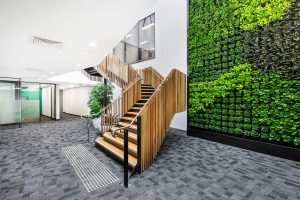How do I get my colour schemes to work with us?
Taren Hura, Interior Designer
Colours are as complex as you want them to be. One moment you’re moving from understanding primary and secondary colours to desperately trying to remember
the colours of the rainbow. Next thing you know, a client has suggested a burnt sienna feature wall opposite the kitchenette. How do you respond?
As a designer often thrown out into a blizzard of differing preferences, objections and strong suggestions, it’s vital that I stay objective and cleave
to a logical approach. Logic and science are rarely welcome in a discussion on overtly subjective subjects such as colour schemes and favourite hues.
But trust me, they not only belong, they are needed – desperately. Yet it is still difficult to know where to start for the uninitiated. Colour choices
for commercial office fit outs are often hotly
contested by emotions, predispositions and of course the corporate logo. Let’s start there.
Careful, the first step is a doozy
A lot of people would head straight to the logo when thinking about colour schemes for their workplace, particularly if they had a feature wall or two
in mind. While this approach certainly has a logical line through the thinking, you may want to think again here. As always, “functionality” must be
considered first. It is often thought that functionality’s role in design comes to a close the moment the location and number of workstations, data
points and power outlets has been settled. Not so.
There are countless articles littering the internet on colour psychology. There is even such a thing as colour therapy but that’s for another time. The
point being that the lick of paint you’re thinking of for that meeting room is going to do more than stand there passively looking attractive. The
fact of the matter is, it might just do the exact opposite if you’re not careful.
This logo is making me hungry
It is not only fair, it’s absolutely accurate to suggest that some fast food companies have poured huge sums into ensuring that their marketing imagery
looks good enough to eat. That goes for logos, menus boards and portraits of the glorious burgers that adorn them. They are designed with one action
and one reaction in mind. To stimulate the appetite and get customers reaching for their money. They are relying, in part, on the selected colour combinations
to “create the need” as toothy sales presenters everywhere might shout (with a little fist pump thrown in). That’s the power of colour psychology in
action.
So, we can agree that in many cases, bright red for example, can be used to awaken hunger or provoke action or even violence. Perhaps we can also agree
that a quiet study room in a library should not be painted red, just because the council to which it is aligned sports a streak of red through its
logo. Imagine the carnage if the library vending machine got jammed! Similarly, white (as in hospital ward white) can evoke assurances of cleanliness,
order and confidence. Again, white would be the wrong choice of dominant colour for the reception area of an avant garde creative ideas incubator –
maybe.
Some examples – the following is not an exhaustive list of colours and their corresponding consequences/inferences but it does illustrate the need to handle
them with care:
Black – power, elegance, death, evil, and mystery.
Light red – joy, passion, sensitivity and love.
Deep red – rage, courage, longing, malice, and danger.
Dull yellow – decay, envy and illness.
Orange – passionate, creative, loud, brash, abrasive, even aggressive
Dark blue – knowledge, power, integrity, and seriousness.
Just to complicate matters further, the suggested meanings of certain colours may vary in accordance with their use. For example a splash of black in an
office by no means screams dire consequences for the visitor. The feelings evoked by certain colours are often heavily influenced by the colours with
which they are combined.
Colours are also coloured by the company they keep
“Blue and green should never be seen.” Okay, there’s a starting point. However, if that was true, we’d all be shielding our eyes from landscapes featuring
blues skies and yes, green grass. So again, context is key here and to establish context and work through and identify useful colour combinations,
we need an element of science to guide us.
For a start, we know that some colour combinations just work well together and some, unfortunately, do not. At its most simplistic, the colour wheel splits
into the three primary colours – red, yellow and blue. Rest assured, these colours can work well together. However when they are mixed to create a
secondary and then a tertiary palette, selections become more complicated.
A good question to ask is, “how would we want people to respond to the colour scheme in this area and what function do they need to fulfil?” The answer
should guide every other decision from here on in. From here we can combine what we know about the company and its corporate livery to decide if a
feeling of warmth (excitement, creativity, desire) is required. Perhaps a cool atmosphere (calm, assured, dependable) would be more useful. Now we
can look at various, established combinations that work well, generally described as complementary, split-complementary, analogous, rectangular, square
and triangular.
All of which is to say that there is a system that can be relied upon that produces colours that work well together. However the key to getting these colours
to work with you, instead of against your stated intent, is to be very clear on what you want these colours to say, imply or shout.




